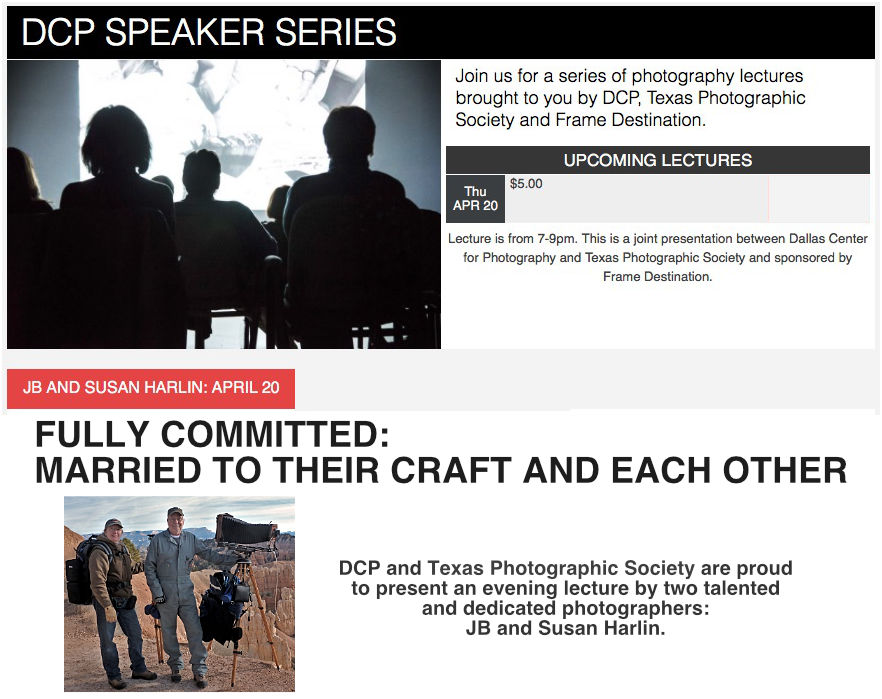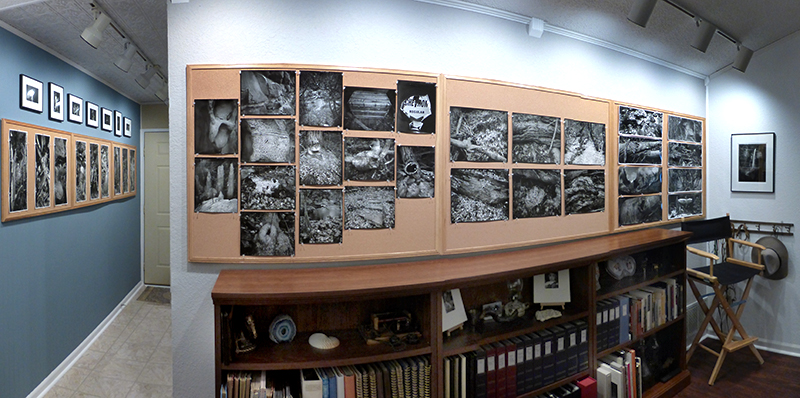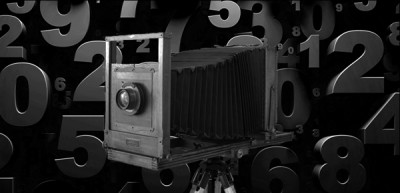ULF Photography
FROM THE ROAD; 2017 TRIP TO UTAH
We have returned home from another trip photographing in Utah. We did come home a couple of days early due to impending winter weather here in Texas. It was near warm out West, while everything from Texas Eastward was in the deep freeze. We did have an excellent trip and we had an amazing time finding new things and making new photographs of some of our favorite places.
Here are a few statistics from this year’s trip:
DAYS ON THE ROAD TOTAL: 29
DAYS IN BRYCE CANYON NP: 3
DAYS IN SPRINGDALE, UT: 16
DAYS IN MOAB, UT: 5
NUMBER OF DAYS PHOTOGRAPHING: 16
SUSAN 4X10 FILM: 87
SUSAN 8X20 FILM: 7
JB 8X10 FILM: 67
JB 11X14 FILM: 12
TOTAL MILES DRIVEN: 3,745
It will take us some time to get the film processed, sorted, filed and proofed. Hopefully we brought back more interesting photographs to print. We invite everyone to follow us on our Web Site, our BLOG and FaceBook. For those of you that traveled with us and followed our ‘FROM THE ROAD’ 2017 emails, thanks for traveling with us! We have gathered all of the emails into a PDF you can view here:
FROM THE ROAD 2017
Hope you enjoyed traveling with us, it is always fun sharing the ‘From the Road’ updates.
JB & Susan
THANKS EVERYONE FOR COMING OUT!
We would like to thank everyone that attended our presentation last Thursday evening at the DCP. We had an energetic group of photographers and photography enthusiasts. A special thank you to the DCP for including us in their 2017 DCP Speaker Series, the Texas Photographic Society and Frame Destination! Here are a few photos from the evening courtesy of Courtney. . .
JB & Susan
DCP SPEAKER SERIES; 04/20/2017
Hello Everyone; Mark your calendar for April 20, 2017 and join us at the DCP for an evening of traditional photography. We will be giving a talk titled “FULLY COMMITTED: MARRIED TO THEIR CRAFT AND EACH OTHER.” We will also have cameras and associated gear, along with a few original photographs on display.
Looking forward to seeing you at the DCP!
JB & Susan
TRANSPARENT TECHNIQUE
 “It is a truism that the more skillful the photograph, the more invisible the art of creation. If the photographer had done a competent job, his insights become so lucid, universal and accessible that they seem to belong to the observer of his work. What follows, then, is the assumption that the viewer could have produced the work. This, in spite of all evidence to the contrary, is why the myth endures that the photographer merely pulls out a picture as a dentist extracts a tooth.”
“It is a truism that the more skillful the photograph, the more invisible the art of creation. If the photographer had done a competent job, his insights become so lucid, universal and accessible that they seem to belong to the observer of his work. What follows, then, is the assumption that the viewer could have produced the work. This, in spite of all evidence to the contrary, is why the myth endures that the photographer merely pulls out a picture as a dentist extracts a tooth.”
ZONE VI NEWSLETTER by Fred Picker, Number 45, December, 1985, p.8
I believe that people think I must spend most of my time building and testing. It is true that I do spend time in my shop building and modifying equipment. I spend a lot of time in the darkroom testing and experimenting with the photographic process. But believe me, I only do what is necessary to make my images say what I want. It is about finding what works, and making it work the way I want. I like to think of the technique as being transparent. I do not want the process to get in the way when I am out working. I want to concentrate, without distraction, as much of my working time as possible on my subject. I do not want to be distracted with the process.
We have had very few malfunctions on the road with the equipment. I attribute that to being aware, and up to date with keeping everything in proper operating condition well before we head out. Most problems we have had in the field are minor, mostly adjustment related and are taken care of once we return home. We do spend a lot of time in preparation for a long photography trip. Details are worked out well before we leave. Everything from a detailed calendar, hotel reservations, cleaning and testing equipment, loading film holders, even down to a packing check list. But that is all part of good planning.
This is what must be done before hand to help insure your creativity once in the field. You have to get all of the technical stuff out of the way. That is where you start. Learn the process. . . make it your own and do not let it get in the way of your creativity. Get all of the logistics organized and out of the way. Your technique should be as transparent as possible.
JB
NOTE: If you have a set of the ZONE VI NEWSLETTER by Fred Picker, read Number 45, December, 1985, for an interesting discussion of the art of photography. Also, I have an index available for download. Follow this LINK to our Articles area, scroll down the page and look for the “COMPLETE ZONE VI NEWSLETTER INDEX ISSUES #1 THROUGH #83.”
TIME FOR A CHANGE & A NEW TRIPOD BOX
 We decided to retire our 2006 Chrysler Town & Country minivan this year and move into something a little bigger for road trips. This minivan has served us well for the last ten years. It has traversed from the Pacific to the Atlantic coasts. . . more than once. But, there comes a time when you need to look into making changes. We have loaded this little Town & Country and the previous Plymouth Grand Voyager to the hilt and trekked off on road trips many times. But, there comes a time when you need to reassess the situation.
We decided to retire our 2006 Chrysler Town & Country minivan this year and move into something a little bigger for road trips. This minivan has served us well for the last ten years. It has traversed from the Pacific to the Atlantic coasts. . . more than once. But, there comes a time when you need to look into making changes. We have loaded this little Town & Country and the previous Plymouth Grand Voyager to the hilt and trekked off on road trips many times. But, there comes a time when you need to reassess the situation.
We have worked out a loading scheme that allows us to carry the main cameras we use, but there is more! I have not hauled the 16×20 camera in near 10 years now. It is just too much to fit into a minivan. Seeing how our Town & Country is now 10 years old and just turned over 100k miles, we started thinking about something new.
It has taken 3 months of research, a lot of looking and just thinking about what our traveling goals really are. We wanted something a bit larger, without all the fluff of computed-out over the top luxury vehicles, like the current minivans all seem to be obsessed with. What we wanted was a TRUCK! We looked at a pickup with a topper, but that did not suit our goal. Everything we found in a van was either massively big, or ridiculously small.
On the last trip to Utah we had the opportunity to see a lot of rental vehicles on the road and in the parks. That along with a lot of searching the Internet, it was becoming obvious we were not finding anything that would work for us. Near giving up, on a day lost to rain in Springdale, UT, I found something searching the Internet one more time. There is one vehicle that fit between too much and too little. More research, and then a visit to a dealer, after we returned home, pretty much sold us on the idea that we had found a vehicle that would work well for us.
We finally settled on the Nissan NVP 3500 12-passenger van. This is a relatively new vehicle, just going into production in 2012. The NV is basically a Nissan Titan truck built into a van. They have several models that are sold with no interior for work trucks. But, Nissan did something that makes real sense. They build a passenger model, with full interior and seating for 12 people. We drove one and decided this, minus the seats, would be just fine for us.
The NVP has become very popular with large families and are somewhat hard to find. . . at least if you want a particular color or configuration. We made a request for what we wanted and sure enough, the salesman found one and had it brought in for us to see. That did it. . . Sold!
We spent a few hours at the dealership and brought the blue NVP home. First order of business. . . remove the seats. They are removable and are just latched to the floor. Into the storage barn they went. Next we needed to build a new tripod box. Took a little time and some CAD work to come up with a new box and a way to get it mounted to the floor. Had to design a mount that would attach to the factory seat hold downs in the floor and then build a new box to hold four tripods.
Some plywood, some glue, some aluminum bar stock, a few dozen deck screws, assorted hardware, sawing, machining and finally a luxurious covering with speaker carpet and there you have it. The tripod box is installed and ready for the road. Now we need to get out. . . and yes the 16×20 will be back on the road!
And not to forget the 2006 T&C. . . we removed the tripod box that has been in it for the last ten years and put the factory seats back in. It now looks just like it did when we first got it. The 1999 Plymouth Grand Voyager with near 170k miles had to go and was sacrificed as the trade-in.
Yes. . . it is Time For A Change!
JB
THANK YOU, EVERYONE!
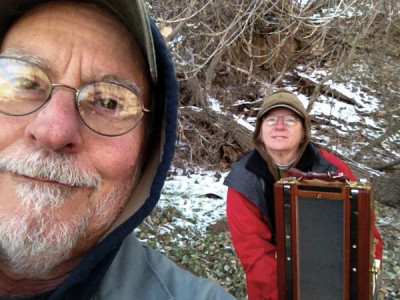
Susan and her 4×10, Zion NP
We spent the greater part of last December traveling in Southern Utah. We visited Bryce Canyon NP, then traveled to Zion NP and the area surrounding Springdale. Next we ventured to Moab, where we visited Arches NP and Canyonlands NP. Hope everyone enjoyed our random From The Road emails and thanks for traveling along with us! We will put up a travel album on our web site as soon as we get a little time.

Susan and her 4×10, Zion NP
Don’t forget the selfie! That seems to be the latest fad and though irritating at times, the preverbal ‘selfie’ has its appeal. We are no different, I guess. We did make a few obligatory selfies on our last trip. Saw a few people with those selfie sticks. . . some were pointed out car windows or an open moon roof while driving. Really wonder what kind of images they got? Having said all that, and not to be out done, we include a few here for your viewing pleasure. . .
Needless to say, we have quite a bit of film to process and that will take at least another month before we begin to see what we brought back. In a world of instant gratification (keep that selfie stick out of my face!), there are those that can’t understand how anyone could be that patient. This is one of the greatest attributes of LF and ULF film photography. It teaches you patience. You take your time when finding a subject. You spend even more time composing the image. Making that exposure is a one time thing. You make sure. . . then you make doubly sure, before you expose that one sheet of film. You know that you will not even get an inkling of what you captured for quite some time, so you give it your best and hope what you do pays off.

We continue to follow our passion for LF and ULF film photography and do send our deepest heart felt thanks to everyone for your continued support. Each year there seems to be more and more interest in film and is extremely encouraging. Happy New Year to all. Hope everyone has a great 2016!
Agin, Thank You Everyone!
JB & Susan
DO YOU LIVE WITH YOUR PRINTS?
It is always fascinating to see your finished photographs hanging in an exhibition space. Mounted, matted, framed and properly lit, they always make me ask myself, did I really do that? This is what fine art photography is all about. It is not about the camera, the film, the tripod, the developer. . . it is all about that finished photograph. Do you really care what brand of saw or chisel was used to craft a piece of fine furniture?
In today’s world of here today, gone in five minutes (or less), it seems people do not appreciate, nor are they particularly interested in long-term anything. Quickly snap a selfie, post it to social media, laugh and move quickly to the next nothing. No one prints photographs anymore. We are losing that engagement that comes from holding a printed image in our hands. . . or enjoying it on the wall for days, years or a lifetime. But, as usual, I have strayed way off topic and begun to ramble.
The print is what photography is all about. I wish I could make more prints from the negatives I have, but it is a difficult task to make fine prints. I find that I have to be in the right mindset to print. If I cannot clear my mind and concentrate on printing, it is nothing but an effort in futility. I would venture to say that I print, at best, 10% of the film I shoot. I find that after printing for several weeks off and on, that I need to take a break and look at what I have done.
During the printing process, I really don’t take a lot of time to really deeply look at what I am doing. I have selected the negative that I believe will make an image that I will like. I have studied it carefully, made my best selection and feel the content of the negative is sufficient to warrant printing. At this point I am in darkroom mode; involved in the process of shape, form, light and texture. I have a good idea of what I want in the print and I am absorbed in the process of coaxing everything I can from that finished print. But do I really look at the print? Not in a sense of seeing what is there. . . not in a sense of living within the finished photograph. That comes later. I am concentrating on getting the print done and making sure the process is completed as it should be.
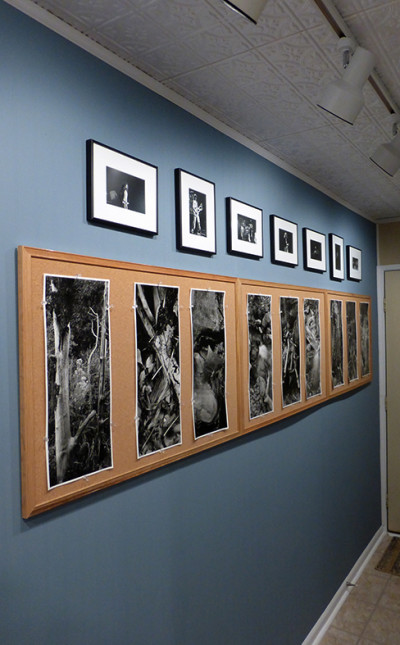
Days later, maybe even weeks later, once the print is dry and flattened, then I really get to study what I have done. I can shuck away all that technical chatter and look objectively at the print. . . and only the print and its contents. I like to look at the finished images and study them carefully for flaws, or mistakes I made in the darkroom. I look carefully at the photograph and if I am happy with what I see, it is time to move to the next step.
This is where Living With The Print begins. We have two large cork boards illuminated with track lighting just for this purpose. I like to pin up my finished images and look at them. . . on the wall. . . under proper illumination. . . for an extended period of time. How long? Weeks; maybe multiple weeks; depends on many factors. My wife and I both put our finished prints up and look at them. . . over some amount of time. After a while it becomes obvious if something is not right. Maybe the composition is just not acceptable; then discard the print, go back and try making another negative. Maybe the printing is not what it could be; go back to the darkroom and print it again. Maybe it just doesn’t work at all; discard the print and try something else.
These are all choices you have to make on your own. It is up to you to determine whether your photograph is exactly what you want; or does it miss the mark? Should it be reprinted; or should the entire idea be abandoned? Sometimes, older negatives that didn’t make it the first time can be reprinted years later and make a more than suitable finished print. You change. . .your vision changes. . . your skills as a printer change. . . or your idea of what you want to express may change. Never say never!
The important thing is to Live With Your Photographs. . . that way you will know if you have been able to say what you want with your hard-earned finished work.
JB
WHY COMPLAIN SO MUCH?
 It seems that I hear a lot of bellyaching about this or that when discussing getting out with a view camera. I wish it really were that easy, but working with large cameras and sheet film is not something that is trivial nor easy. Here are a few complaints I have heard;
It seems that I hear a lot of bellyaching about this or that when discussing getting out with a view camera. I wish it really were that easy, but working with large cameras and sheet film is not something that is trivial nor easy. Here are a few complaints I have heard;
-
My dark cloth is not dark enough
-
My dark cloth is too heavy
-
My ground glass is not bright enough
-
I want one of those inverting viewers
-
My lens is not exactly the one I want
-
My camera is not sturdy enough
-
My tripod is too heavy
-
It is way too hot (that one is mine)<
-
It is way too cold (not for me)
It is much too easy to complain rather than to just suck it up and get to work. Nothing is ever perfect and if you really want to get out and expose film, you will learn to work with whatever you have, in whatever conditions may occur. I believe most of this is more about using complaints as an excuse not to get out and make photographs as it is about reality. As I said, making photographs is difficult hard work, especially with a large view camera. It requires dedication and a stick-to-it kind of mindset.
Let me address some of these items from my viewpoint;
-
I have never had a dark cloth that wasn’t dark enough. If the cloth is black on the inside and relatively thick it is plenty good enough to see your ground glass. The main purpose of the dark cloth is to cancel any light and reflections on the ground glass so you can see to compose and focus. It will seldom be cave dark if you are out in bright sun. Quit looking at how bright it is and concentrate on the ground glass.
-
Yes, if you have a 100% opaque dark cloth, then the odds are it will be heavy and even cumbersome to use. May not always be the case, but everything is a trade off.
-
The ground glass is not a computer screen. . . it will never be as bright as a TV or computer screen. In my experience everything I have tried makes things worse for me. I tried a Fresnel. . . once. . . not for me. Yes it was brighter, but the lines broke the image up to the point I could not easily focus. I got rid of it and learned to use what I had. I prefer a plain ground glass. I have learned to use it. Remember to let your eyes get accustomed to the dark when you get under the dark cloth. The longer you stay under there the better you will see. Be patient.
-
I have said this before and I will repeat; nothing will improve your composition any more than looking at your subject upside down. This is a fact. . . get used to it. . . use it to your advantage. . . it is true!
-
Don’t go there. . . optimally you need, a short, a medium, and a long focal length lens. If you can’t afford all three, compromise and learn to use what you have till you can afford something else. Not a good excuse.
-
Everything in a mechanical design is a tradeoff. The lighter and smaller your camera folds, the less sturdy it will be. . . fact of life. Remember: The camera only has to be still when the shutter is open!
-
Tripods are another tradeoff. Light tripod; less sturdy, more prone to vibration. Heavy tripod: more sturdy, less prone to vibration. You get to choose. Me, I carry a 19 pound wooden tripod for 8×10 and 11×14. I wouldn’t use anything else.
-
This is my worst area. So far as I am concerned, when it gets to 80F, it is way too hot for humans to function. Working with a large camera, I begin to draw the line at 50F. And, I am not going to get over it! Being sick and suffering heat exhaustion is not a fun time, nor is it creative.
-
Too cold. . . what is that? I prefer to work well under 40F. We have worked at near 0F and survived. My rule; if I break a sweat, time to head home. See, I also whine!
Nothing is ever perfect and the lack of perfection is not an excuse for not making photographs. You can always find some reason not to get out, how about finding something worth exposing a sheet of film on instead of complaining? When I wrote this it was the middle of July, 103.8F, with a dew point of 62F on the back porch. I don’t even want to look outside, let alone go outside in this kind of weather. I have whittled my list of complaints and excuses down to hot weather. . . how about you?
JB
I have never had a dark cloth that wasn’t dark enough. If the cloth is black on the inside and relatively thick it is plenty good enough to see your ground glass. The main purpose of the dark cloth is to cancel any light and reflections on the ground glass so you can see to compose and focus. It will seldom be cave dark if you are out in bright sun. Quit looking at how bright it is and concentrate on the ground glass.
Yes, if you have a 100% opaque dark cloth, then the odds are it will be heavy and even cumbersome to use. May not always be the case, but everything is a trade off.
The ground glass is not a computer screen. . . it will never be as bright as a TV or computer screen. In my experience everything I have tried makes things worse for me. I tried a Fresnel. . . once. . . not for me. Yes it was brighter, but the lines broke the image up to the point I could not easily focus. I got rid of it and learned to use what I had. I prefer a plain ground glass. I have learned to use it. Remember to let your eyes get accustomed to the dark when you get under the dark cloth. The longer you stay under there the better you will see. Be patient.
I have said this before and I will repeat; nothing will improve your composition any more than looking at your subject upside down. This is a fact. . . get used to it. . . use it to your advantage. . . it is true!
Don’t go there. . . optimally you need, a short, a medium, and a long focal length lens. If you can’t afford all three, compromise and learn to use what you have till you can afford something else. Not a good excuse.
Everything in a mechanical design is a tradeoff. The lighter and smaller your camera folds, the less sturdy it will be. . . fact of life. Remember: The camera only has to be still when the shutter is open!
Tripods are another tradeoff. Light tripod; less sturdy, more prone to vibration. Heavy tripod: more sturdy, less prone to vibration. You get to choose. Me, I carry a 19 pound wooden tripod for 8×10 and 11×14. I wouldn’t use anything else.
This is my worst area. So far as I am concerned, when it gets to 80F, it is way too hot for humans to function. Working with a large camera, I begin to draw the line at 50F. And, I am not going to get over it! Being sick and suffering heat exhaustion is not a fun time, nor is it creative.
Too cold. . . what is that? I prefer to work well under 40F. We have worked at near 0F and survived. My rule; if I break a sweat, time to head home. See, I also whine!
Nothing is ever perfect and the lack of perfection is not an excuse for not making photographs. You can always find some reason not to get out, how about finding something worth exposing a sheet of film on instead of complaining? When I wrote this it was the middle of July, 103.8F, with a dew point of 62F on the back porch. I don’t even want to look outside, let alone go outside in this kind of weather. I have whittled my list of complaints and excuses down to hot weather. . . how about you?
JB




